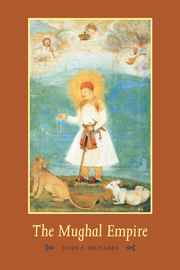Book contents
- Frontmatter
- Contents
- List of maps and tables
- General editor's preface
- Preface
- Introduction
- 1 Conquest and stability
- 2 The new empire
- 3 Autocratic centralism
- 4 Land revenue and rural society
- 5 Jahangir 1605–1627
- 6 Shah Jahan 1628–1658
- 7 The War of Succession
- 8 Imperial expansion under Aurangzeb 1658–1689
- 9 The economy, societal change, and international trade
- 10 Maratha insurgency and Mughal conquest in the Deccan
- 11 The Deccan Wars
- 12 Imperial decline and collapse, 1707–1720
- Conclusion
- Glossary
- Bibliographic essay
- Index
- THE NEW CAMBRIDGE HISTORY OF INDIA
10 - Maratha insurgency and Mughal conquest in the Deccan
Published online by Cambridge University Press: 28 March 2012
- Frontmatter
- Contents
- List of maps and tables
- General editor's preface
- Preface
- Introduction
- 1 Conquest and stability
- 2 The new empire
- 3 Autocratic centralism
- 4 Land revenue and rural society
- 5 Jahangir 1605–1627
- 6 Shah Jahan 1628–1658
- 7 The War of Succession
- 8 Imperial expansion under Aurangzeb 1658–1689
- 9 The economy, societal change, and international trade
- 10 Maratha insurgency and Mughal conquest in the Deccan
- 11 The Deccan Wars
- 12 Imperial decline and collapse, 1707–1720
- Conclusion
- Glossary
- Bibliographic essay
- Index
- THE NEW CAMBRIDGE HISTORY OF INDIA
Summary
Shortly after Aurangzeb's accession a surprising new source of resistance to Mughal political domination appeared. In the hilly areas of the western Deccan, around Puna, the Maratha leader Shivaji Bhonsla (1627–1680) was carving out a self-sufficient state within the enfeebled shell of the Sultanate of Bijapur. The Bhonsla regime offered a new option for ambitious and aggressive men from both the Maratha warrior caste and literate Maratha Brahmin castes. So successful was Shivaji that by the 1660s he seriously threatened Mughal prestige and domination in the south.
Shivaji was the second son of Shahji Bhonsla, a Maratha general and aristocrat, and Jija Bai, daughter of one of the great Maratha noblemen in the Sultanate of Ahmadnagar. In the early 1630s Shahji had led an ultimately futile attempt to set up a young Nizam Shah ruler as his puppet. When Ahmadnagar was swallowed up by the Timurids, Shahji took service in the Karnatak campaigns of the Sultan of Bijapur. Shahji retained control of his large fief in the western Ghats near Puna. The Sultan of Bijapur had de facto ceded political control of much of the western Ghats to the powerful Maratha chiefs or deshmukhs in that remote area.
Shivaji was raised by Jija Bai, Shahji's estranged wife, at Puna as a rustic Maratha aristocrat. Unlike Shahji's other sons, Shivaji was not indoctrinated into the Persianate high culture of the Bijapur court.
Keywords
- Type
- Chapter
- Information
- The Mughal Empire , pp. 205 - 224Publisher: Cambridge University PressPrint publication year: 1993

